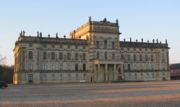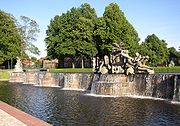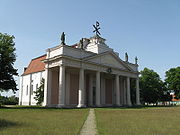
Schloss Ludwigslust
Encyclopedia

Germany
Germany , officially the Federal Republic of Germany , is a federal parliamentary republic in Europe. The country consists of 16 states while the capital and largest city is Berlin. Germany covers an area of 357,021 km2 and has a largely temperate seasonal climate...
. It was built as a hunting lodge, rebuilt as a luxurious retreat from the ducal capital, Schwerin
Schwerin
Schwerin is the capital and second-largest city of the northern German state of Mecklenburg-Vorpommern. The population, as of end of 2009, was 95,041.-History:...
, then became for a time (1765–1837) the center of government. It was the "joy" of Prince Christian Ludwig
Christian Ludwig II, Duke of Mecklenburg-Schwerin
Christian Ludwig II of Mecklenburg was the Duke of Mecklenburg [-Schwerin] from 1747 to 1756.He was the son of Friedrich I of Mecklenburg-Schwerin and Christine Wilhelmine, princess of Hesse-Homburg...
, the son of the Duke of Mecklenburg-Schwerin
House of Mecklenburg
The House of Mecklenburg is a North German dynasty of West Slavic origin that ruled until 1918.- Origins :Niklot was a lord of the Wendish tribe of Obotrites. When the Holy Roman Empire expanded eastwards, notably to the coast of Baltic in 13th century, a portion of Obotrite lords allied with...
, hence the name Ludwigslust.
Origins
Ludwigslust had its origins in a simple hunting lodge within a day's ride (36 km) of the ducal capital, SchwerinSchwerin
Schwerin is the capital and second-largest city of the northern German state of Mecklenburg-Vorpommern. The population, as of end of 2009, was 95,041.-History:...
. In 1724 Prince Christian Ludwig
Christian Ludwig II, Duke of Mecklenburg-Schwerin
Christian Ludwig II of Mecklenburg was the Duke of Mecklenburg [-Schwerin] from 1747 to 1756.He was the son of Friedrich I of Mecklenburg-Schwerin and Christine Wilhelmine, princess of Hesse-Homburg...
, the son of the Duke of Mecklenburg-Schwerin
House of Mecklenburg
The House of Mecklenburg is a North German dynasty of West Slavic origin that ruled until 1918.- Origins :Niklot was a lord of the Wendish tribe of Obotrites. When the Holy Roman Empire expanded eastwards, notably to the coast of Baltic in 13th century, a portion of Obotrite lords allied with...
, decided to build a hunting lodge on this site, near a hamlet called Klenow. Even after he became duke in his turn in 1747, he passed most of his time at this residence, which he called Ludwigslust
Ludwigslust
Ludwigslust is a town in Mecklenburg-Vorpommern, Germany, 40 km south of Schwerin. It was the capital of the former district of Ludwigslust, and is part of the district Ludwigslust-Parchim since September 2011.-History:...
("Ludwig's joy").
Residenz
In 1765, Duke Friederich made Ludwigslust the capital of the duchy instead of Schwerin. Consequently the little town that had already grown in the service of the schloss, was further expanded, and a cornerstone for a new, grander residenz was laid directly behind the old hunting box in 1768. In the years 1772-1776 Ludwigslust was rebuilt to plans by Johann Joachim Busch. The Late BaroqueBaroque architecture
Baroque architecture is a term used to describe the building style of the Baroque era, begun in late sixteenth century Italy, that took the Roman vocabulary of Renaissance architecture and used it in a new rhetorical and theatrical fashion, often to express the triumph of the Catholic Church and...
Schloss is built on an E-plan foundation, with a higher projecting central corps de logis
Corps de logis
Corps de logis is the architectural term which refers to the principal block of a large, usually classical, mansion or palace. It contains the principal rooms, state apartments and an entry. The grandest and finest rooms are often on the first floor above the ground level: this floor is the...
in three bays, which appears to penetrate its wings from front to rear; the richer Corinthian order
Corinthian order
The Corinthian order is one of the three principal classical orders of ancient Greek and Roman architecture. The other two are the Doric and Ionic. When classical architecture was revived during the Renaissance, two more orders were added to the canon, the Tuscan order and the Composite order...
of the central block contrasts with the Ionic
Ionic order
The Ionic order forms one of the three orders or organizational systems of classical architecture, the other two canonic orders being the Doric and the Corinthian...
of the wings. On the urban side, the central block makes some compromises with the new neoclassical style
Neoclassicism
Neoclassicism is the name given to Western movements in the decorative and visual arts, literature, theatre, music, and architecture that draw inspiration from the "classical" art and culture of Ancient Greece or Ancient Rome...
in the flat planes of the façade, which simply occupies one flank of the square centered on it, without embracing the space in a cour d'honneur
Cour d'Honneur
Cour d'Honneur is the architectural term for defining a three-sided courtyard, created when the main central block, or corps de logis, is flanked by symmetrical advancing secondary wings, containing minor rooms...
(illustration, below left) and in the severe Doric portico
Doric order
The Doric order was one of the three orders or organizational systems of ancient Greek or classical architecture; the other two canonical orders were the Ionic and the Corinthian.-History:...
. The structure is brick, clad in the local sandstone; forty over-lifesize allegorical figures, also in sandstone, by Rudolf Kaplunger, alternating with vases, crown the low attic above the cornice.

Piano nobile
The piano nobile is the principal floor of a large house, usually built in one of the styles of classical renaissance architecture...
, or Festetage ("Reception floor"), above a low ground floor that contained guestrooms. The Goldener Saal ("Gilded Hall") in the central block rises through two storeys, with a colossal order of Corinthian columns and massive decorations carried out in stucco and the innovative moldable and modelable paper-maché called Ludwigsluster Carton; it is used today for summertime concerts. One flanking range was semi-public, with a sequence of antechamber, salon and audience chamber, and a gallery. The opposite range was semi-private, with the Duke's drawing-room and bedchamber (hung with framed miniatures), a cabinet and a gallery with a porcelain chimneypiece.
The Schloss was the center-point of a range of grand buildings sited in deference to it, including the Hofkirche that served as the court chapel. A central avenue through the town was laid out, centered on the Schloss; on the garden side the axis was carried through as the Hofdamenallee ("Court ladies' allée
Allee
Allee may refer to:* Alfred Allee , U.S. sheriff.* J. Frank Allee , U.S. merchant and politician.* Warder Clyde Allee , U.S. ecologist, discoverer of the Allee effect.* Verna Allee , U.S. business consultant....
"), a central ride through the enclosing woodland, still reaching the slightly elevated wooded horizon today.
The palace's surrounding Schlosspark of 120 ha. was laid out with formal canals, fountains and a frankly artificial cascade, tamed of all the wildness that a later, Romantic generation
Romanticism
Romanticism was an artistic, literary and intellectual movement that originated in the second half of the 18th century in Europe, and gained strength in reaction to the Industrial Revolution...
would venerate; it was built according to sketches by the French architect Jean-Laurent Le Geay
Jean-Laurent Le Geay
Jean-Laurent Le Geay was a French neoclassical architect with an unsatisfactory career largely spent in Germany. His artistic personality remained shadowy until recently, though he was allowed to have had numerous pupils among the avant-garde of neoclassicism...
, who had laid out the formal garden at Schwerin in 1749-55, but was quickly overtaken at Ludwigslust by his assistant, Johann Joachim Busch, who began the work in 1763. The trees laid out in the pattern and at the scale of Bernini's colonnades in Piazza San Pietro have disappeared, but there are the neoclassical stone bridge designed by Busch about 1780, with a cascade that falls across a lip so perfectly regular that it has the name Der Waltze (the "Roll"), a grotto
Grotto
A grotto is any type of natural or artificial cave that is associated with modern, historic or prehistoric use by humans. When it is not an artificial garden feature, a grotto is often a small cave near water and often flooded or liable to flood at high tide...
built as a ruin, a Gothic chapel, two mausoleums and a monument to a favourite horse.

Peter Joseph Lenné
Peter Joseph Lenné was a Prussian gardener and landscape architect from Bonn who worked in the German classicist style.-Childhood and development:...
. Water near the schloss was recast in more naturalistic manner and the surrounding woodland edges were varied, with clumps of trees as outliers, but the main axia Hofdamenallee centered on the palace, still stretches dead straight through the woods, and the narrow Great Canal, laid out at an angle to one side, still extends a kilometer and a half.

Jean-Baptiste Oudry
Jean-Baptiste Oudry was a French Rococo painter, engraver, and tapestry designer. He is particularly well known for his naturalistic pictures of animals and his hunt pieces depicting game.-Biography:...
and busts by Jean Antoine Houdon that represent the tastes of the Mecklenburg dukes.
In 1844 William Makepeace Thackeray
William Makepeace Thackeray
William Makepeace Thackeray was an English novelist of the 19th century. He was famous for his satirical works, particularly Vanity Fair, a panoramic portrait of English society.-Biography:...
set a high-living episode of his amoral eighteenth-century hero Barry Lyndon
The Luck of Barry Lyndon
The Luck of Barry Lyndon is a picaresque novel by William Makepeace Thackeray, first published in serial form in 1844, about a member of the Irish gentry trying to become a member of the English aristocracy...
at Ludwigslust, where Barry, pursuing a countess, is accompanied by a black page named Zamor who is dressed in Turkish attire, and his pavilion is "fitted up in the Eastern manner, very splendid.

